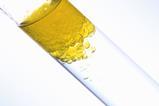Investigate the basicity of toothpastes and give context to neutralisation reactions
Everyday neutralisation is a topic often introduced when teaching acids and bases to give real-world relevance to something that can seem inherently suited to the science classroom. In the past, I have tasked pupils with finding everyday examples of neutralisation reactions which would rectify deleterious changes in pH. They find examples online, such as: ammonia on a bee sting and vinegar on a wasp sting. However, insect stings contain a mixture of substances, some of which are acidic, and neutralisation is not the remedy, which is also the case with nettles and dock leaves. These examples are unsuitable for giving context to neutralisation and have become myths that need challenging, along with other online examples such as all toothpastes being alkaline and farmers using lime (CaO) to raise soil pH.
Download this
Practical worksheet on the basicity of toothpastes from the Education in Chemistry website: rsc.li/3nubMnJ
In the past, I’ve often prioritised the acid–alkali reaction as this takes the most classroom time due to the practical technique of doing titrations. However, when it comes to everyday pH adjustments, the acid–insoluble base reaction – or even just dilution – has a much more important role, which I previously overlooked.
Is toothpaste basic?
I decided to investigate the often-stated fact that toothpastes are used to neutralise mouth acid after being unable to find any information about toothpastes being basic, as advertised. I turned it into an investigative practical – ‘Is toothpaste basic?’ – to highlight the differences between alkalis and bases, and add relevance and purpose to a research task that could otherwise be perceived as relatively dry.

After teaching how to test pH and neutralisation, I ask pupils to design a practical to discover which toothpastes actively neutralise acids – some toothpastes are neutral, some are basic and some are alkaline. I found that pupils had to think hard about neutralisation involving insoluble bases. Acid–insoluble base neutralisation reactions have no possibility of an alkaline mouth cavity after brushing.
From my own research, I found that a low pH is bad for teeth, whereas I couldn’t find any information that a high pH (from ‘normal’ dietary foods) is detrimental. A neutral pH toothpaste would, of course, reduce mouth cavity acidity purely by dilution, which is interesting. Pupils found the activity an engaging and exciting way of testing online information and liked the real-life relevance linking their chemistry knowledge to commercially available products.
Farming, fiery foods and foaming
The same understanding can be applied to soil pH and indigestion. Famers use acid–insoluble base neutralisations on their crops with agricultural lime (calcium carbonate) rather than the more soluble bases of quicklime and slaked lime, calcium oxide and calcium hydroxide respectively. Using an insoluble base makes sense as the soil won’t become alkaline. Similarly, with acid indigestion tablets, calcium or magnesium carbonates are often used, which are other examples of acid–insoluble base neutralisations. The tablets react to remove acidity by neutralisation, without reaching alkaline conditions. Why not repeat the toothpaste practical described here with indigestion tablets and compare the resultant pHs?
Neutralisation reactions are also used in shampoos to control the pH. Shampoos are soapless detergents and as they are salts of weak acids, you might expect them to be alkaline. But they are adjusted to be on the acidic side of neutral and this slight acidity helps make hair shiny. Try washing your hair with (alkaline) soap and notice the difference. Baths bombs, on the other hand, are created using a neutralisation reaction resulting in a pleasing effervescence to disperse colour and scent in your bath. While we enjoy mostly soft water in Scotland, other areas of the UK must deal with limescale from calcium carbonate precipitation. Removing this with household vinegar is another example of using a neutralisation reaction to ensure heating elements work efficiently and pipes remain unblocked.
Acid neutralisation by alkalis understandably deserves a significant amount of time investment so students can develop technical titration skills. However, acid–insoluble base neutralisation is arguably more useful in everyday situations and this emphasis is sometimes lost in the use of frivolous urban myths like relieving pain from insect bites. Acid–insoluble base neutralisation does not require an indicator to measure the end point. Overshooting neutrality is also not an issue, and so acid–insoluble base neutralisation provides an ideal reaction to help your students understand this topic.
More resources
- Carry out this experiment using indigestion tablets to neutralise an acid: rsc.li/35chjtb
- Use these activities to explore the chemical concepts involved in hair care, shampoos and conditioners: rsc.li/32lHPPG
- Share this job profile of a consumer products technician who uses polymers to solve problems in everyday products: rsc.li/3FMQ6cZ
More resources
- Carry out this experiment using indigestion tablets to neutralise an acid, with teacher notes and student questions to download.
- Use these activities to explore the chemical concepts involved in hair care, shampoos and conditioners.
- Share this job profile of a consumer products technician who uses polymers to solve problems in everyday products.
- Find more problem-solving activities to engage, motivate and develop the key skills of your 11–14 and 14–16 learners.
Duncan Short















No comments yet